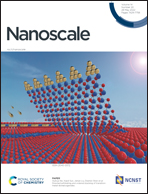Pressure-stimulus-responsive behaviors of core–shell InP/ZnSe nanocrystals: remarkable piezochromic luminescence and structural assembly†
Abstract
Piezochromic luminescence materials with optical properties can be adjusted (the colors most sensitive to the human eye range from red to green) to provide powerful means for information acquisition in various applications. Inorganic quantum dots, typically based on heavy metals such as cadmium and lead, have congenital advantages as luminescence materials, including strong inoxidizability and excellent photoelectric properties. However, small band-gap shifts under pressure have hindered the development of inorganic-based piezochromic materials. Herein, we combined in situ high-pressure photoluminescence (PL) and absorption measurements with synchrotron X-ray scattering spectra to elucidate the remarkable modulation of optical properties and morphologies by pressure, particularly that of the piezochromic luminescence, in all-inorganic core–shell InP/ZnSe nanocrystals (NCs). We observed a stepwise PL color change from red to green, and an ultrabroad bandgap tunability of 0.46 eV was observed from 1.99 to 2.45 eV in the pressure range of 14.2 GPa for InP/ZnSe NCs. Moreover, two-dimensional (2D) InP/ZnSe nanosheets were synthesized by the stress-driven attachment of nanoparticles. These results demonstrate the ability of the pressure-stimulus response to trigger remarkable piezochromic luminescence and 2D nanosheet assembly in InP/ZnSe NCs, which paves the way for new applications of all-inorganic InP-based semiconductor NCs.

- This article is part of the themed collection: 2022 Nanoscale HOT Article Collection


 Please wait while we load your content...
Please wait while we load your content...